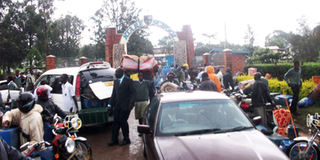School strikes: Who should take the blame?

Parents pick their children from Ntare School after it was closed following a strike. Photo BY ALFRED TUMUSHABE
Mbarara
Secondary schools in the country are back into destructive and bloody strikes that have claimed lives and property. The strike causes range from poor feeding to indiscipline, academic to sports rivalry. The traditional schools that were once household names at national level in academics are no more and the best out of them are the strikes that has in most cases left many injured and property destroyed. Institutions closed and students sent home.
Educationists and administration experts point to poor communication by the school administrators and betrayal the staff that instigate students against the administration and general indiscipline among the students that make unrealistic and unfair demands. In the recent Bubaare SS strike in Kabale in which a life was lost, the students were against the school administration’s call not to sit boy and girl during preps ahead of the end of term examinations.
Causes of strikes
School strikes cannot be roundly blamed and condemned on one pillar of the schools’ management. Communication, feedback and dissemination of information is paramount. However, some school managers often ignore this and without weighing the implications. Though the students’ bodies (prefects) are in each and every school, they are not effectively used yet they are capable of detecting an impending strike.
Schools have also been in a rush to admit students without taking note of their track record of discipline. Some students are expelled from schools and end up being easily admitted in another for the sake of money (school fees). Though the strikes have continued to happen in schools, the teachers’ association has not done much to avert them.
The Uganda Teachers Association National Vice Chairperson, Mr James Tweheyo, says that much as they meet as head teachers quite often, the hardly discuss strikes in schools. “We don’t meet often. Even not for issues related to strikes since foundation bodies are always holding seminars and meetings to address issues within the schools,” Mr Tweheyo said in an interview. He said the riots in schools are only addressed as they happen.
The government policy
Tweheyo said that the liberalization of education is partly to blame as it doesn’t offer quality education and acceptable discipline of the learners. Some private schools have been licensed without meeting the minimum requirements and they have consistently lacked supervision. The education “investor” sometimes are out to maximize profits at the expense of the students and parents/guardians.
Private schools have advertised massively and attracted students from neighbouring Kenya, Tanzania, Rwanda, Sudan, Burundi and the DRC. This new phenomena is due to the apparently good education we provide, cheaper than their home countries but again very hard for the school managers to trace the students’ background. This severely puts the managers of the schools at risk of managing the general discipline.
Rivalry
It is ironic that such rivalries between neighbouring schools, which were sometimes non-violent but occasionally degenerated into ferocious clashes, were what used to personify the competitive spirit in such institutions. In academics, there were the famous rivalries between King’s College, Budo and St. Mary’s College, Kisubi among the boys’ schools in the central region, as well as the three-way battle between Mt. St. Mary’s Namagunga, Nabisunsa Girls School and Gayaza High School for the girls’ schools in central.
Eastern Uganda was home to academic contests between Busoga College, Mwiri and Kiira College Butiki, or Nabumali High School, Tororo College and Teso College, Aloet in the Far East. In northern Uganda, the academic rivalries were often between St. Joseph’s College, Layibi and Lango College. The mark of these academic rivalries is that the school did not even have to be immediate neighbours to compete against one another.
As a result, some relatively less-known schools like St. Joseph’s College, Ombaci in West Nile, Lango College in the north, Immaculate Heart Secondary School in the west often produced some of the best students in the country, and were spurred on by those often sporadic feats to try and punch above their academic weight against the traditional giants. But that is as far as healthy competition went. In other, more violent rivalries, students sustained permanent injuries while others sometimes lost their lives from fights with counterparts in neighbouring schools. In eastern Uganda, Manjasi and Tororo College often had running battles motivated by rivalry over Tororo Girls’ School.
In the west only in 2009, students of Booma High School in Mbarara took three students from Mbarara High School hostage after a football match did not go in their favour. The students were later released, and relations between Mbarara High School and their nemesis Ntare School, with whom they did not see eye-to-eye for several years over Bweranyangi Girls School, have since improved.
Last year, Butobere SS students in Kabale allegedly attacked their Kigezi High School counterparts over football match. This resulted into death of a senior one student of Kigezi College Butobere during a football-related altercation with students from Kigezi High School. It has since reopened old wounds and revealed a vice that was prevalent countrywide before the 2000s. But again today, the strikes that are coming up are being generated within the schools.
The recent strikes at Kiira College Butiki, Bubaare SS in Kabale, Ntare School in Mbarara have been within the schools. Tweheyo says that if the school managers do not address issues of communication and bridge the gaps in information flow, strikes will always happen.




